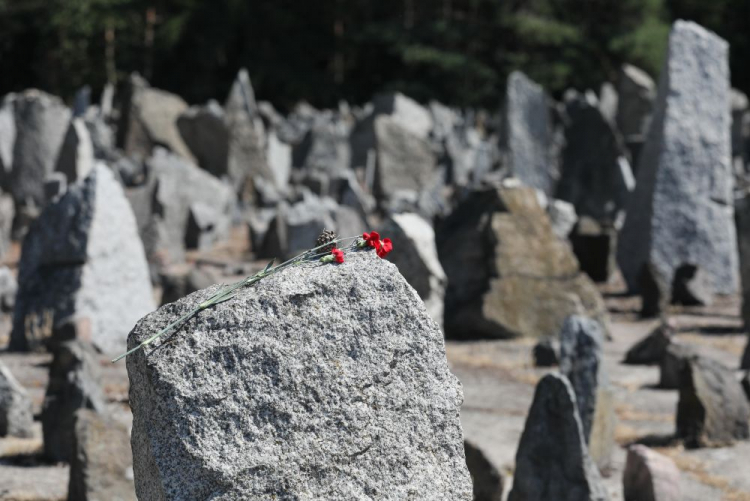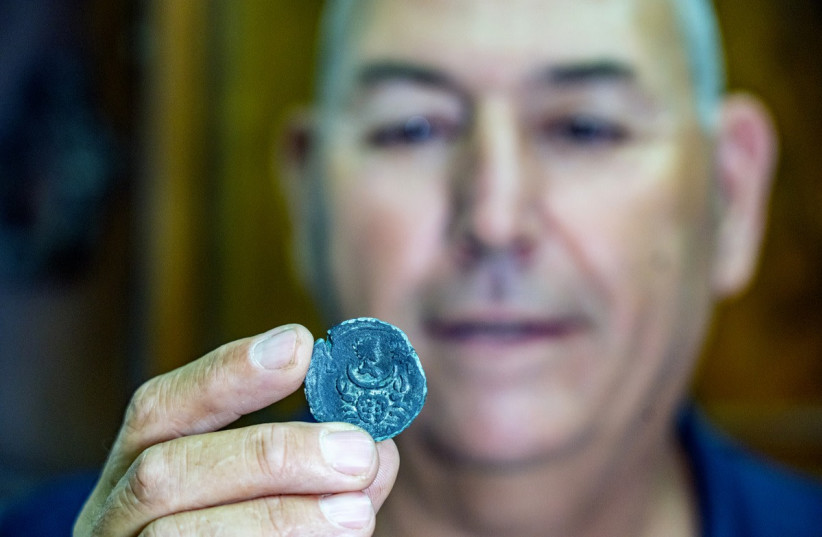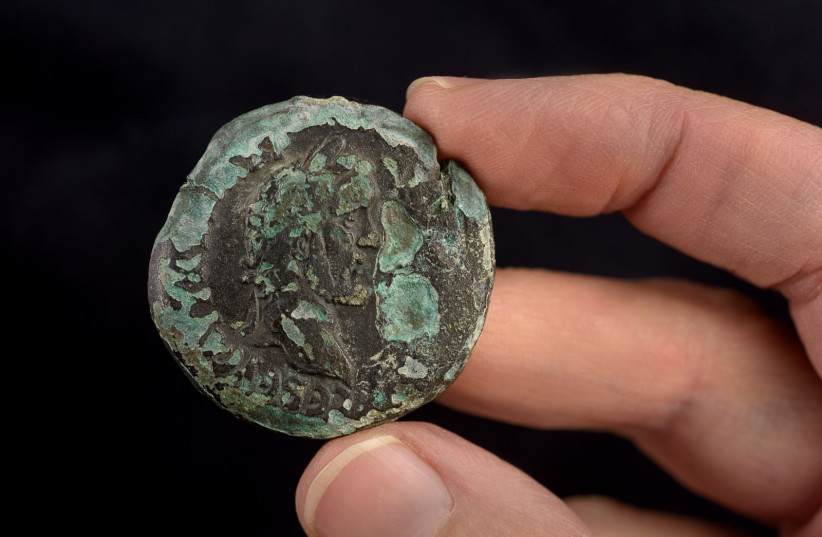 Treblinka, 02.08.2022. Uroczystości upamiętniające 79. rocznicę powstania w obozie zagłady w Treblince. Fot. PAP/P. Supernak
Treblinka, 02.08.2022. Uroczystości upamiętniające 79. rocznicę powstania w obozie zagłady w Treblince. Fot. PAP/P. Supernak
 W Treblince uczczono 79. rocznicę buntu więźniów niemieckiego obozu zagłady
W Treblince uczczono 79. rocznicę buntu więźniów niemieckiego obozu zagłady
Michał Szukała
Nie wolno dopuścić, aby kiedykolwiek powtórzyły się zbrodnie, jakich dopuścili się funkcjonariusze nazistowskiej III Rzeszy – napisał prezydent Andrzej Duda w liście do uczestników obchodów powstania więźniów niemieckiej fabryki śmierci w Treblince w 1943 r.
Prezydent przypomniał, że bunt przeciwko niemieckiej machinie zagłady „przyniósł wyzwolenie tylko nielicznym uczestnikom walki”, ale pamięć o tamtych wydarzeniach nie została przekreślona przez wykonawców i architektów zbrodni. „Dziś cały świat zna historię tego miejsca, które jest jednym z symboli Holocaustu. Jest naszą powinnością – współczesnych Polaków, Żydów, Europejczyków – aby strzec prawdy o tym co wydarzyło się tu i w innych niemieckich obozach. Nie wolno dopuścić, aby kiedykolwiek powtórzyły się zbrodnie, jakich dopuścili się funkcjonariusze nazistowskiej III Rzeszy” – napisał prezydent. Dodał, że przesłanie odrzucenia nienawiści, płynące z tamtej epoki musi być przekazywane z pokolenia na pokolenie.
„Dzisiejsza uroczystość poświęcona jest ludziom, którzy w tym piekle rozpoczęli walkę o prawo do życia, godność i wolność, dając dowód heroizmu i udowadniając, że zło nie jest wszechmocne” – napisała marszałek Sejmu RP Elżbieta Witek w liście do uczestników uroczystości. Do moralnego znaczenia wydarzeń z 1943 r. odniósł się także premier Mateusz Morawiecki, który w odczytanym liście zwrócił uwagę, że uczestnicy buntu dążyli także do zatrzymania machiny śmierci, której częścią był ten obóz zagłady. Przypomniał także o niepowodzeniu okupantów, którzy dążyli do wymazania tego miejsca z historii.
Na współczesny kontekst wydarzeń sprzed 79 lat zwrócił uwagę w swoim liście do uczestników uroczystości wiceminister kultury i dziedzictwa narodowego Jarosław Sellin, który porównał walkę prowadzoną przeciwko niemieckiemu narodowemu socjalizmowi do walki toczonej z najazdem rosyjskim na Ukrainie. „Życie dopisuje nowe konteksty do dawnych dramatów. Już od pięciu miesięcy wydaje się, że Rosja +rozwiązuje kwestię ukraińską+. Budzi to nasze wielkie oburzenie. Dlatego pochylając się nad z szacunkiem nad nadludzkim bohaterstwem i oddając cześć niewinnym ofiarom ludobójstwa zaplanowanego i zrealizowanego przez aparat III Rzeszy okażmy naszą solidarność z ofiarami bestialskiego gwałtu Rosji na Ukrainie i Ukraińcach” – podkreślił wiceminister Sellin.
„Była to walka straceńców o godność i człowieczeństwo” – mówiła dyrektor Żydowskiego Instytutu Historycznego Monika Krawczyk. Zacytowała wspomnienia jednego z przywódców buntu Samuela Willenberga, który pisał, że tego dnia „więźniowie nie myśleli czy pozostaną przy życiu”, a ich jedynym celem było „zniszczenie fabryki śmierci”. Przypomniała, że powstanie w Treblince nie było końcem walki prowadzonej przez Samuela Willenberga, który niemal dokładnie rok później walczył w Powstaniu Warszawskim. „W tych dniach jest to nam szczególnie bliskie” – podkreśliła.
Dyrektor ŻIH przypomniała, że miejsce po niemieckiej fabryce śmierci jest największym cmentarzem polskich Żydów, ale ginęli w tym miejscu także przedstawiciele innych narodowości, między innymi Polacy i Romowie, a także Żydzi przywożeni tu z innych krajów okupowanych przez Niemców. „Przemawia do nas groza tego miejsca” – podkreśliła Monika Krawczyk.
Ambasador Izraela Jakow Liwne podziękował władzom RP za zainteresowanie miejscem pamięci w Treblince, między innymi plany budowy centrum edukacyjnego sąsiadującego z terenem obozu. Dodał, że jest to szczególnie gest szczególnie istotny w kontekście niemieckich prób zacierania śladów zbrodni po likwidacji obozu jesienią 1943 r.
Po zakończeniu uroczystości Ada Willenberg, wdowa po Samuelu Willenbergu, odsłoniła kamień węgielny pod budowę nowego pawilonu edukacyjnego. Willenberg podkreśliła, że budowa Centrum Edukacji o Zagładzie Żydów w Muzeum Treblinka jest realizacją woli jej męża, który od lat osiemdziesiątych oprowadzał wycieczki zwiedzające teren dawnego obozu zagłady i wielokrotnie podkreślał, że w przyszłości historycy będą potrzebowali miejsca do prowadzenia działań edukacyjnych, gdy zabraknie świadków niemieckich zbrodni. Według umowy zawartej przez Adę Willenberg z Muzeum Treblinka część rzeźb autorstwa jej męża będzie prezentowanych w tym miejscu.
2 sierpnia 1943 r. w obozie wybuchł bunt przygotowany przez grupę konspiracyjną, w skład której wchodziło m.in. kilku wojskowych umiejących posługiwać się bronią. Zaatakowano strażników i podpalono zbiornik z paliwem. Więźniowie podpalili także część baraków obozowych, nie udało im się jednak zniszczyć komór gazowych.
Obóz zagłady w Treblince wybudowany został przez Niemców w połowie 1942 r. obok istniejącego w pobliżu karnego obozu pracy przeznaczonego dla Polaków. Pierwszym komendantem był doktor medycyny Irmfried Eberl, po nim funkcję tę objął Franz Stangl. Pierwszy transport przybył 23 lipca 1942 r., znaleźli się w nim Żydzi z getta warszawskiego; kolejne transporty pochodziły z terenów okupowanej Polski oraz m.in. z Niemiec, Austrii, Bułgarii, Francji, Czechosłowacji i ZSRS. Według szacunków historyków, w Treblince zginęło ok. 900 tys. osób. Większość z nich – ok. 760 tys. – pochodziła z terenów II Rzeczypospolitej.
2 sierpnia 1943 r. w obozie wybuchł bunt przygotowany przez grupę konspiracyjną, w skład której wchodziło m.in. kilku wojskowych umiejących posługiwać się bronią. Zaatakowano strażników i podpalono zbiornik z paliwem. Więźniowie podpalili także część baraków obozowych, nie udało im się jednak zniszczyć komór gazowych. Tylko niewielka część powstańców posiadała broń i amunicję, którą wynieśli ze zbrojowni SS, pozostali mogli stanąć przeciw dobrze uzbrojonej załodze obozu jedynie z siekierami, nożami, prętami czy młotami. Głównym celem było sforsowanie ogrodzenia i ucieczka do lasu. Udało się to ok. 200 więźniom, Szacuje się, że końca wojny doczekać mogło nie więcej niż 100 spośród nich.
Obóz w Treblince powstał w ramach Akcji Reinhardt, czyli zaplanowanej przez Niemców zagłady Żydów na terenie Generalnego Gubernatorstwa, która rozpoczęła się od likwidacji getta w Lublinie w nocy z 16 na 17 marca 1942 r. Już we wrześniu 1941 r. naziści zdecydowali o budowie na tym obszarze obozów zagłady, które powstały m.in. w Bełżcu, Sobiborze, na Majdanku i w Auschwitz-Birkenau; do listopada 1943 r. zamordowano ok. 2 mln Żydów; łączną liczbę przedstawicieli ludności żydowskiej, zamordowanych przez Niemców i ich sojuszników w trakcie II wojny szacuje się na ok. 6 milionów. Tegoroczne obchody w Treblince, przygotowane przez Żydowski Instytut Historyczny, Muzeum Treblinka i MKiDN, są częścią upamiętnienia ofiar akcji Reinhardt.(PAP)
Zawartość publikowanych artykułów i materiałów nie reprezentuje poglądów ani opinii Reunion’68,
ani też webmastera Blogu Reunion’68, chyba ze jest to wyraźnie zaznaczone.
Twoje uwagi, linki, własne artykuły lub wiadomości prześlij na adres:
webmaster@reunion68.com






